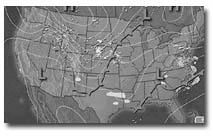|
 The
routine was basic but exact. The
routine was basic but exact.
He’d walk through
the front door, slip off his jacket, crack the lid on
a can of domestic and take his seat in front of the Technicolor.
It seemed that he followed the most standard of American
rituals, but he was no television junkie. The dial rarely
changed.
Every evening, my dad
tuned into the forecast in a continuing quest to solve
the mystery of the weather. The addiction worsened with
the advent of cable TV and an upstart station known as
the Weather Channel. It wasn’t long before he was
fully hooked on the jet-stream, began to understand the
details of barometric pressure and was introduced to isobars.
My brother and I watched
this rhythm and intensity from a distance. “It must
be the chicks,” I suggested, eyeing a slender brunette
in tweed as she showed off her alleged degree in meteorology.
My brother only nodded as he stared open-mouthed at the
screen.
In truth, it was a little
more obvious. My dad lived and worked in the ski industry.
He didn’t go as far as some of his friends and co-workers,
who mailed off for their own digital barometers and mini-weather
kits, but he had an undying affection and passion for
weather forecasts. It was only natural. During the winter,
weather – particularly foul weather – was
the high mark of his livelihood.
A few years after that
brunette in tweed showed up, I sold my skis and shipped
off for an East Coast college. After a few short months,
I got my first taste of an East Coast storm. Snow flashed
in the forecast, and people started talking apocalypse.
Canned goods sold out instantly, batteries went into high
demand and advertisements for generators came over the
air. When that big, bad front eventually hit, it dumped
slightly more than an inch of wet slop on the roads, enough
to derail Virginia life for well over 24 hours. Streets,
schools and stores shut down, and life as we knew it halted.
Still, I was a little
surprised to see that a bunch of my college buddies had
fallen head-over-heels for a meteorologist who was now
wearing a snappy, blue suit.
After a few East Coast
winters, one of which hosted “the Storm of the Century,”
a six-inch whopper that piled up cars all along the eastern
seaboard, a summer job took me to Alaska. Living in a
plywood cabin on the incredibly remote Kalgin Island,
a 50-square-mile chunk of rock without a single road,
electrical pole or television, I learned a different approach
to meteorology.
Running a 20-foot skiff and working the coastline for
salmon, the weather – particularly good weather
– was the high mark of our livelihood. Foul weather
meant crawling into a rubber suit at 5 a.m. and battling
big seas and arctic chill in an effort to bring in the
catch. We understandably became a little weather-obsessed
after the skiff, loaded with thousands of Coho salmon,
nearly swamped in a gale. However, we were also cut off
not just from Technicolor, but from electricity and newsprint.
Consequently, we tried
to tune in to what the atmosphere was telling us, tried
to sniff isobars with our noses and feel low pressure
in our bones. And like most big-money meteorologists,
we were natural-born failures.
Over a cup of coffee,
one of us would predict a clear and sunny day of pulling
nets and inadvertently invite 45 mph winds and 12-foot
waves. Another would conjure up the mother of all storms
over a smoke, and we’d wake to a placid day of sunshine
and nets teeming with fish. Our whole system eventually
became a big joke, and rain or shine we went about our
days with smiles on our faces. Our secret was adaptation,
“keeping our knees bent,” as a friend of mine
remarked recently.
Since that summer on
Kalgin Island, I’ve tried hard to keep them bent,
particularly where the great unknowns, like weather, are
concerned. The approach has since comfortably squeezed
me through a tropical storm, a couple seasons when the
rivers weren’t exactly running, one of the harshest
winters I’ve ever seen (a two-month ice storm in
Washington D.C., believe it or not), some pretty slim
ski seasons and a summer of wildfire.
And as Durango’s
weather has shifted in the last week from Indian summer
into early winter, I’m trying hard to avoid that
brunette in tweed. I’ve heard every possible prediction
for the upcoming winter from “biggest in 20 years”
to “another dud.”
The real trouble is
that I’m itching for some turn time, and the forecast
has been a little hard to resist. But I’m trying
to keep those knees bent, or at least my inside knee.
And I’m working on adapting, adapting to some knee-deep.
At least that’s what my nose is telling me.
-Will Sands
|

